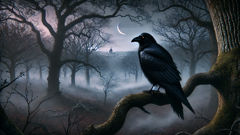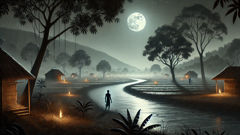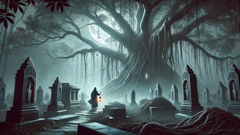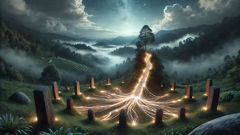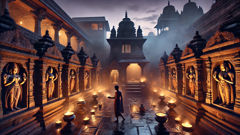Introduction
In the wild heart of medieval Jutland, where endless pine and beech forests stretched into shadow and the wind sang strange songs through the trees, the villagers of Skovlund lived with an old, persistent fear. They whispered of a creature that dwelled between worlds—a monstrous raven as black as the northern night, known only as the Valravn. The stories told of its hunger for innocence and its unholy ambition, for the Valravn was no ordinary bird: it carried the curse of a knight slain in battle, denied peace, and transformed by rage and envy into a cunning, immortal predator. Its eyes, they said, glowed with a cruel intelligence, and its cry in the darkness foretold disaster. Children were warned never to stray far from the firelight, for the Valravn hungered for hearts unspoiled by sorrow, and legends insisted that only by consuming the heart of a child could the beast shed its feathers and don the armor and flesh of a man once more. Yet the Valravn’s transformation was never one of redemption—it became a knight only in outward form, carrying with it all the malice and hunger of its raven self, now hidden behind a handsome, cold smile. Many dismissed such tales as the superstitions of shepherds and crones, but others—those who had seen shadows move just beyond the torchlight, who had found black feathers at the windowsill or heard the flapping of great wings in the moonless hours—knew better. This is the story of one fateful winter when the Valravn’s legend came to life, setting in motion a battle for souls and a revelation that the line between man and monster is thinner than anyone dares admit.
Whispers in the Wood
The village of Skovlund had endured many winters, each one leaving its mark on the old timbered houses and the faces of those who called this place home. When the snow came early, blanketing the land in white silence, it brought more than hardship—it awakened old fears. Every family gathered their children close, shuttered their windows, and offered prayers to the Virgin and to any old gods who might still listen. Yet some dangers could not be barred by wood or warded by prayer. It began with the disappearance of livestock. Sheep vanished from the farthest pastures, their tracks ending abruptly at the forest’s edge. Black feathers turned up in odd places—wedged in doorframes, drifting on icy streams, stuck in the thatch above sleeping children. The village priest, Father Henrik, counseled calm and called for greater faith. But the old healer, Marta, whose hands smelled always of herbs and earth, looked to the woods with narrowed eyes and muttered words that chilled even the boldest farmers.
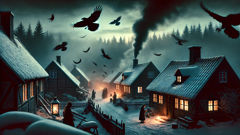
In a cottage at the village’s edge lived Erik Halvorsen, a widower with a daughter named Astrid. Erik was not given to flights of fancy, but even he felt the world shift that winter, as if something ancient had stirred. Astrid, just nine years old, was as lively as springtime—curious, quick to laughter, and beloved by all. She’d been born under a blue moon, and Marta had always said that children born on such nights were marked by fate. One evening, as Erik mended a broken fence by torchlight, Astrid came running, cheeks flushed, her arms full of kindling. She stopped suddenly, her eyes fixed on a shadow in the branches overhead. Erik followed her gaze and saw it—a raven larger than any he’d known, feathers dark as midnight, watching them in silence. Its head cocked to one side, unblinking, unafraid. Erik shooed it away, but the bird did not move. Only when Marta’s dog barked from across the field did the raven take flight, its wings stirring the snow into ghostly eddies.
That night, Erik dreamed of black wings and sorrow. He woke to find Astrid’s bed empty and the front door ajar. Panic seized him; he called her name, but only silence answered. In the gray predawn, he found her at the forest’s edge, standing barefoot in the snow, staring into the trees as if listening to a distant song. When he gathered her in his arms, she was cold as stone, her lips blue, and she would not speak a word. Marta was summoned, and she wrapped Astrid in warm blankets, placing charms of rowan and salt at her bedside. Still, the girl’s eyes remained wide and distant, as if she had glimpsed something far beyond human sight. The village rallied around Erik, but fear gnawed at every heart: the Valravn had chosen its prey. That day, black feathers fell from the sky as if snow had turned to shadow. The villagers whispered that this was a sign, a warning of hunger yet to come.
For days, Astrid drifted in and out of feverish sleep, her small hands clutching at something unseen. Marta watched over her, muttering prayers in Old Danish, grinding roots and berries for potions that filled the cottage with bitter scents. Erik’s grief deepened, mingled with guilt—he had not listened to the old tales, and now his daughter was lost somewhere between life and death. Meanwhile, in the heart of the forest, the Valravn circled an ancient burial mound. Its hunger had grown fierce, but it was cunning; it would not strike until the time was ripe. It watched the village, studied its fears, and waited for the night when its transformation could be complete.
A Bargain with Shadows
As Astrid’s sickness deepened, Erik refused to leave her side. He barely ate or slept, haunted by memories of her laughter and the chilling stillness that had replaced it. Marta stayed in the cottage, tending to the girl and keeping the hearth burning. Outside, the village grew tense. Each morning brought new signs—animals skittish or missing, elders claiming to see a great shadow flitting between the trees at the edge of their sight. The men gathered at the inn to share stories and sharpen blades, but none dared venture into the forest after dark.
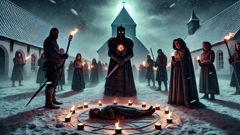
Marta, for all her knowledge, was troubled. She whispered to Erik that there was more at play than mere illness or fright. She recalled tales from her childhood, stories her grandmother had told her by candlelight. The Valravn, she said, could not cross the threshold unbidden, but it could call to those whose spirits had been weakened by sorrow or longing. Its voice was said to be as sweet as lullabies and as cold as grave earth. Erik’s heart ached with guilt—he knew Astrid missed her mother dearly, especially in winter, and he wondered if that longing had left her vulnerable to the Valravn’s call.
One night, as a blizzard raged outside, Erik awoke to find Astrid gone again. Her footprints led into the woods. Fear clenched his chest, but he plunged into the snow, torch in hand. The forest was alive with storm and darkness, branches clawing at him as he stumbled deeper. He followed a trail of black feathers until he reached a clearing. There, beneath an ancient oak, stood Astrid, her nightgown glowing pale in the moonlight. Opposite her perched the Valravn. Its wings were spread wide, its beak parted in a song Erik could not hear but felt in his bones—a melody of longing, loss, and temptation.
Erik called to Astrid, but she didn’t turn. The Valravn fixed him with its fiery gaze. He felt his will draining away, replaced by an overwhelming sorrow and desire—to have his wife back, to erase all pain. In that moment, he understood the beast’s power: it offered not just terror but hope twisted into despair. With all his strength, Erik staggered forward, breaking the trance. He swept Astrid into his arms and ran, never looking back.
Back in the village, Astrid fell into a deep, unnatural sleep. Marta declared that the time for waiting was over. She spoke of an old ritual—one that could protect Astrid’s soul, but only if her father was willing to make a sacrifice. Erik was desperate enough to agree, but Marta warned him: the price of defying the Valravn would not be paid in blood alone.
At midnight, they gathered in the churchyard. Marta drew runes in the snow with ash and rowan wood. Erik knelt beside Astrid, clutching a locket that had belonged to her mother. Marta began to chant, her voice rising above the wind. Suddenly, a gust extinguished their torches. Out of the darkness came the Valravn—no longer a bird, but a figure clad in rusted mail, its face hidden by a black helm. Its eyes still burned with raven’s fire. The villagers shrank back as the Valravn stepped into the circle. It spoke in a voice like breaking ice: ‘Give me the child, and your pain will end. Deny me, and all you love shall perish.’
Erik wept, torn between terror and love. But Marta stood firm. She offered the beast a bargain: if it could answer her riddle—a riddle of love and memory—it could claim what it sought. The Valravn agreed, but its pride was its undoing. It failed to answer, for it had forgotten all but hunger and ambition. Enraged, it attacked. Marta flung powder into its face; Erik shielded Astrid with his body. The Valravn shrieked and vanished in a storm of wings and snow, leaving behind a single black feather and a promise to return.
The Heart of Winter
The defeat of the Valravn was only temporary; its rage now burned brighter than ever. The snow deepened, and food grew scarce. Some villagers believed the worst was over, but others—those who had looked into the eyes of the knight—knew the true battle was yet to come. Marta worked tirelessly to fortify Astrid’s spirit. She taught Erik old songs, had him string rowan berries above every door, and instructed the village children to wear amulets woven from their mothers’ hair. Still, unease clung to Skovlund like a second skin.
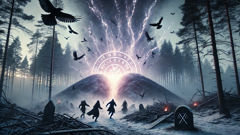
Winter’s heart arrived with a bitter wind that howled through every crevice. One evening, as Erik tended the fire, Astrid stirred at last from her deep sleep. She opened her eyes and spoke in a voice not quite her own: ‘He waits beneath the old stones, Father. He calls for me.’ Erik’s blood ran cold. Marta hurried to her side, examining Astrid’s pulse and eyes. She pronounced that there was only one way to end the Valravn’s curse forever—the source of its power had to be found and destroyed.
With nothing left to lose, Erik prepared for the journey. Marta gave him a pouch of charms and a blade forged with iron and silver. Astrid, weakened but determined, insisted on coming. Together with Marta, they set out at dawn, following Astrid’s dreams toward the heart of the forest.
They traveled in silence through ancient groves where the snow never melted, past standing stones carved with forgotten runes. The deeper they went, the colder it became; even breath froze in the air. They reached a burial mound older than memory—a place of restless spirits and bitter secrets. There, they found a circle of ravens perched silently on the stones. At their approach, the birds scattered, revealing a stairway descending into darkness.
The trio entered the barrow, torches guttering. The air inside was thick with sorrow and malice. At the center stood a sarcophagus carved with knightly symbols, draped in tattered banners. Beside it, a black feather gleamed on an altar of ice. As Erik stepped forward, the Valravn appeared—not as bird or knight but as something in between, a shifting shape of feathers and steel. Its voice echoed in every corner: ‘You cannot destroy me. I am the hunger of men who will not rest.’
Marta raised her charms and sang an invocation. Astrid spoke the words she’d heard in her dreams, words that were older than the forest itself. The beast recoiled as the runes carved into the altar began to glow. Erik, heart pounding, thrust the silver blade through the feather, pinning it to the ice.
The Valravn screamed—a sound that shook the earth. Its form splintered and dissolved into smoke and cinders. The barrow trembled as ancient spells unraveled. Erik seized Astrid’s hand, and Marta guided them out as the mound collapsed behind them, sealing away the monster’s power.
The first rays of dawn broke through the trees as they returned to Skovlund. Astrid was whole again; her eyes sparkled with life. The villagers greeted them as heroes, but Marta reminded them that such evil never truly dies—it only sleeps. The legend of the Valravn lived on, a warning to all who would bargain with darkness.
Conclusion
The legend of the Valravn left deep roots in the soil of Jutland and in the memories of Skovlund’s people. For generations, parents told their children to stay near the fire and respect the old ways—never to mock what they did not understand. Though Erik and Astrid returned to a quieter life, both carried scars invisible to others: Erik a deeper humility and gratitude for his daughter’s laughter, Astrid an unshakable sense that the world holds mysteries neither good nor evil can fully claim. Marta grew older but never stopped teaching her remedies and tales, ensuring that wisdom endured alongside warning. And sometimes, on cold winter nights when the wind rattled shutters and shadows stretched across snowy fields, those who listened closely heard a distant caw echo through the trees—a reminder that even vanquished darkness waits in silence for hearts to grow careless or lonely again.

